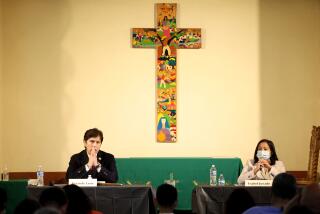New Gang Wars Fuel Candidates’ Positions : Politics: Two shooting incidents this week prompt candidates to call for beefing up of the police force and other anti-gang measures.
- Share via
Violent crime, the issue that is driving campaigns of political hopefuls across Long Beach, took on added significance this week in the wake of two gang-related shootings that claimed three lives and left four others injured.
Several mayoral and City Council candidates in the June 7 election said the incidents underscore spiraling gang crime in a city that needs to take a tougher stand to protect innocent victims.
“We’re at a crisis stage,” mayoral candidate Beverly O’Neill said Tuesday night at a candidates’ forum. “These are big-city problems that we need to start paying attention to.”
O’Neill and her opponent, City Councilman Ray Grabinski, want to beef up the police force in an effort to clear gangs from neighborhoods.
“We’ve allowed the streets to get so mean that we’re afraid to get out on them,” Grabinski said at the forum.
Council candidate Dianne McNinch echoed Grabinski’s sentiments. “Crime is the No. 1 problem, and the city hasn’t done enough about it,” McNinch said.
*
Sunday night, three Latinos were gunned down as they left a party in central Long Beach, where they had gone to advertise a dance club. The victims, all from Los Angeles, apparently were not gang members but were caught in the middle of a war between Latino and Cambodian gangs in Long Beach that has lasted five years, police said.
In a separate incident nearby Tuesday, a Latino youth was shot in the foot when two Asian men drove up and opened fire. The youth was treated and released from a local hospital. Police believe the attacks may have been in retaliation for the shooting deaths of Cambodian gang members earlier this month.
The killings appear to be part of a cycle of gang violence. There were a record 137 homicides in the city last year--of which more than half were gang-related, police said.
In response, candidates are proposing a host of get-tough measures.
Grabinski wants the city to combine forces with federal prosecutors and use racketeering laws against gang members who sell drugs. He also proposes a television show on the local cable station that would air the names and pictures of gang members who are wanted by authorities.
“We need to start making it uncomfortable for bad guys to come to Long Beach,” Grabinski said.
O’Neill wants the police force to be more visible in high-crime areas. She proposes adding 150 police officers over three years and transferring others from desk jobs into the field. The department has 792 sworn officers.
O’Neill and Grabinski have called for an increase in the Police Department’s 26-member gang unit. O’Neill recently unveiled a six-page plan she termed a “counterattack.”
“We need more gang busts,” she said. “We need to make sure the pressure is always there by police.”
Yet a beefed-up police force and a tough stand against violent gang members are only parts of the solution, the candidates said. Both called for more community involvement and after-school programs to give young people alternatives to gangs.
Grabinski has promoted the idea of a community congress that would bring together all neighborhood associations to air their problems, meet with city officials and share tips on combatting crime.
O’Neill, formerly a Long Beach City College president, has called for stepped-up community-based policing with officers assigned to specific neighborhoods.
Candidates in three City Council races have said in recent forums that additional police have to be combined with other plans to help communities fight crime.
Mike Donelon, a candidate in the 7th District, said any increase in the police force should be coupled with programs that encourage youngsters to reject gangs. He said youth programs, local churches and county probation officers should coordinate their efforts.
Donelon’s opponent, Tonia Reyes Uranga, said she plans to make a police substation on the city’s west side a top priority. She also criticized the Police Department for not deploying enough officers to patrol gang-ridden areas of central Long Beach. The district covers central and western Long Beach.
Jenny Oropeza, who is seeking a seat in the 1st Council District, also emphasized the need for early intervention in the areas of academics, jobs and recreation to combat gangs. The district includes downtown and parts of western Long Beach.
“There’s a lot of desperation in the community that incites criminal activity,” Oropeza said, referring to the recent killing and other incidents. “We have to try and create an economic environment where people aren’t desperate and preying on each other.”
All the council candidates, however, said the city must put more police on the streets as a front-line deterrent to crime.
Oropeza said she would add 100 officers, cutting spending in other areas to provide the funding. Her opponent, McNinch, proposes boosting the force by more than 250 officers.
In the 9th District, which covers North Long Beach, first-time candidate Jerry Shultz, a sheriff’s deputy, would add 100 to 150 officers to the force, which he would also like to see supplemented with reserve officers and volunteers who would patrol the streets.
Shultz’s opponent, City Councilman Warren Harwood, said he would propose spending cuts in areas such as funding for the arts to bring the police force to 1,000 officers by 1996, an increase of 208 officers.
More to Read
Sign up for Essential California
The most important California stories and recommendations in your inbox every morning.
You may occasionally receive promotional content from the Los Angeles Times.










